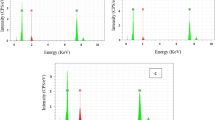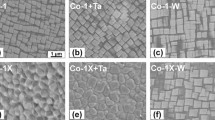Abstract
The oxidation states of minor alloying elements in Zircaloys often determine their resistance to corrosion, especially in nuclear reactors. In particular, tin is of interest because of its near ubiquitous use in earlier Zircaloys. To study changes in the oxidation state of tin under irradiation, specimens of Zr-0.76Fe-1.6Sn were corroded at similar conditions in an autoclave and in a nuclear reactor. Corrosion rates were found to be significantly accelerated following irradiation compared to those in the autoclave. Mössbauer spectroscopy revealed that in both the autoclave conditions and reactor conditions, a combination of tetravalent, divalent, and elemental (β-Sn) tin particles are formed during the initial corrosion processes. The kinetics of both the change in tin oxidation state and the corrosion rate in-reactor are greatly accelerated, pointing to the effect of irradiation driving tin into solution more quickly.
Similar content being viewed by others
References
Filippov, V.P., Bateev, A.B., Lauer, Yu.A., Kargin, N.I.: Mössbauer spectroscopy of zirconium alloys. Hyperfine Interact. 217, 45–55 (2013)
Pecheur, D., Filippov, V.P., Bateev, F.B., Ivanov, Y.Y.: Mössbauer investigations of the chemical state of tin and iron atoms in oxide films of zirconium alloys. In: 13th international symposium on zirconium in the nuclear industry, ASTM STP 1423, pp. 135–153. ASTM STP 1423, Annecy (2001)
Polatidis, E. et al.: Residual stresses and tetragonal phase fraction characterisation of corrosion tested Zircaloy-4 using energy dispersive synchrotron X-ray diffraction. J. Nucl. Mater. 432, 102–112 (2013)
Yilmazbayhan, A., Motta, A.T., Comstock, R.J., Sabol, G.P., Lai, B., Cai, Z.: Structure of zirconium alloy oxides formed in pure water studied with synchrotron radiation and optical microscopy: relation to corrosion rate. J. Nucl. Mater. 324, 6–22 (2004)
Anada, H. et al.: Effect of annealing temperature on corrosion behaviour and ZrO2 microstructure of Zry-4 cladding tube. In: Bradley, E.R., Sabol, G.P. (eds.) Zirconium in the nuclear industry: eleventh international symposium, pp. 74–93. ASTM STP 1295, Garmisch-Partenkirchen (1995)
Yilmazbayhan, A. et al.: Transmission electron microscopy examination of oxide layers formed on Zr alloys. J. Nucl. Mater. 349, 265–281 (2006)
Allen, T.R., Konings, R.J.M., Motta, A.T.: Corrosion of Zirconium Alloys. In: Comprehensive nuclear materials, vol. 5, pp 49–68. Elsevier, Amsterdam (2012)
Garner, A., Hu, J., Harte, A., Frankel, P., Grovenor, C., Lozano-Perez, S., Preuss, M.: The effect of Sn concentration on oxide texture and microstructure formation in zirconium alloys. Acta Mater. 99, 259–272 (2015)
Cheng, A., Gilmore, P.M., Klepfer, H.H.: PWR Zircaloy fuel cladding corrosion performance, mechanisms, and modelling. In: Bradley, E.R., Sabol, G.P. (eds.) Zirconium in the nuclear industry: Eleventh international symposium, ASTM STP 1295, pp. 137–158, Garmisch-Partenkirchen (1995)
Motta, A.T., Couet, A., Comstock, R.J.: Corrosion of zirconium alloys used for nuclear fuel cladding. Annu. Rev. Mater. Res. 45, 311–343 (2015)
Fromhold, A.T.Jr.: Theory of Metal Oxidation, volume 1 of Fundamentals of Defects in Crystalline Solids. North-Holland Publishing Company, Amsterdam (1976)
Youssef, M., Yildiz, B.: Intrinsic point-defect equilibria in tetragonal ZrO2: Density functional theory analysis with finite-temperature effects. Phys. Rev. B 86, 144109 (2012)
Koski, K., Holsa, J., Juliet, P.: Properties of zirconium oxide thin films deposited by pulsed reactive magnetron sputtering. Surf. Coat. Technol. 120–121, 303–312 (1999)
Beie, H.-J. et al.: Examinations of the Corrosion Mechanism of Zirconium Alloys. In: Zirconium in the nuclear industry: Tenth international symposium, ASTM STP 1245, pp. 615–643, Baltimore (1994)
Couet, A., Motta, A.T., Ambard, A.: The coupled current charge compensation model for zirconium alloy fuel cladding oxidation: I. Parabolic oxidation of zirconium alloys. Corr Sci 100, 73–84 (2015)
Seibold, A., Garzarolli, F.: Influence of Composition and Condition on In-PWR Behavior of Zr-Sn-Nb-FeCrV Alloys. In: Moan, G.D., Rudling, P. (eds.) Zirconium in the nuclear industry: Thirteenth international symposium, ASTM STP 1423, pp. 743–757 (2002)
Rudling, P., Wikmark, G.J.: A unified model of Zircaloy BWR corrosion and hydriding mechanisms. Nucl. Mater. 265, 44–59 (1999)
Cheng, B.-C., Kruger, R.M., Adamson, R.B., Garde, A.M., Bradley, E.R.: Corrosion Behavior of Irradiated Zircaloy. In: Zirconium in the nuclear industry: Tenth international symposium, pp. 400–418. ASTM STP 1245, Baltimore (1993)
Gilbon, D., Simonot, C., Garde, A.M., Bradley, E.R.: Effect of Irradiation on the Microstructure of Zircaloy-4. In: Zirconium in the nuclear industry: Tenth international symposium, pp. 521–548. ASTM STP 1245, Baltimore (1994)
Youssef, M., Yang, M., Yildiz, B: Doping in the valley of hydrogen solubility: a route to designing Hydrogen-Resistant zirconium alloys. Phys. Rev. Appl. 5, 014008 (2016)
Wilhelm, R.V., Howarth, D.: Iron oxide Doped Yttria Stabilized Zirconia Ceramics. Am. Ceram. Soc. Bull. 58, 228–232 (1979)
Filippov, V.P.: Changes in the state of tin in the near-surface layers of zirconium alloys at the initial stages of corrosion. Bull. Russ. Acad. Sci. Phys. 79, 1017–1021 (2015)
Sawicki, J.A., Marest, G., Cox, B., Julian, S.R.: Mössbauer spectroscopy of iron implanted and doped in ZrO2. Nucl. Inst. Methods Phys. Res. B 32, 79 (1988)
Shpinel’, V.S.: Rezonans Gamma-Luchei V Kristallakh (Gamma-Rays Resonance in Crystals). Nauka, Moscow (1969)
Babikova, Yu.F., Gruzin, P.L., Filippov, V.P., Ivanov, A.V.: Izv. Vyssh. Uchebn. Zaved., Ser. Fiz. 1, 70 (1981)
Filippov, V.P., Bateev, A.B., Lauer, Y.A., Kargin, N.I., Petrov, V.I.: Changes in the state of iron atoms in Zr alloys during corrosion tests in an autoclave. Hyperfine Interact. 226(1-3), 771–779 (2014)
Shevyakov A.Yu., Novikov V.V., Markelov V.A., Obukhov A.V. , Kobylyansky G.P.: Study of Structure-Phase State of Oxide Films on E110 and E635 Alloys at Pre- and Post-Irradiation Stages. Zirconium in the Nuclear Industry: 18th International Symposium. 598–618 (2017). https://doi.org/10.1520/STP159720160064
Acknowledgements
The work was financially supported by MEPhI’s Competitiveness Program. A. F. Dykhuis and M. P. Short acknowledge funding from the Consortium for the Advanced Simulation of Light Water Reactors (CASL), a U.S. Department of Energy (DOE) Energy Innovation Hub.
Author information
Authors and Affiliations
Corresponding author
Additional information
This article is part of the Topical Collection on Proceedings of the International Conference on the Applications of the Mössbauer Effect (ICAME 2017), Saint-Petersburg, Russia, 3-8 September 2017
Edited by Valentin Semenov
Rights and permissions
About this article
Cite this article
Filippov, V.P., Bateev, A.B., Lauer, Y.A. et al. The influence of reactor irradiation on the oxidation state of tin in Zr-0.76Fe-1.6Sn. Hyperfine Interact 239, 21 (2018). https://doi.org/10.1007/s10751-017-1487-6
Published:
DOI: https://doi.org/10.1007/s10751-017-1487-6




